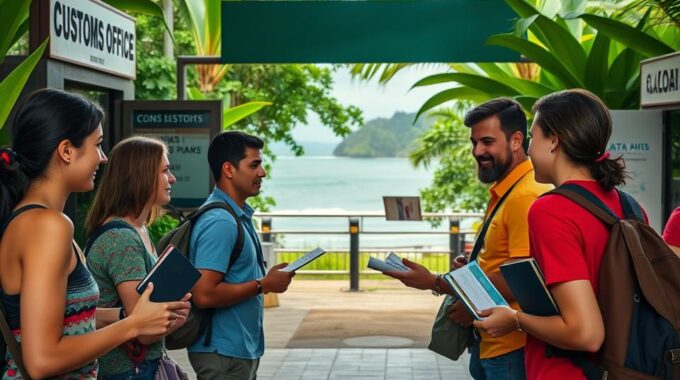As a hub for international workers and service providers, Costa Rica has introduced Law No…

Understanding the Border Run Procedures in Costa Rica: Everything You Should Know.
Ever wondered why some travelers in Costa Rica keep crossing the border to stay longer? Knowing how to handle immigration is key for those wanting to extend their trip or renew their visa. This article will cover the details of the visa renewal process in Costa Rica. It will also explain why following immigration rules is crucial. We aim to give travelers useful tips to avoid legal issues and save time.
Key Takeaways
- The average bus travel time from San Jose to Nicaragua is around six hours.
- Entrance fee to Nicaragua at the Peñas Blancas border is approximately 14 USD.
- It is recommended to stay at least 72 hours outside of Costa Rica to renew a tourist visa for another 180 days.
- There’s an approximate additional cost of 4 USD for the Nicaragua exit fee before returning to Costa Rica.
- Two major bus companies for the journey to Nicaragua are Ticabus and TransNica.
- Customs procedures in Costa Rica are made easier with the implementation of electronic “Single Windows.”
Overview of Border Rules in Costa Rica
Planning a trip to Costa Rica means understanding its border rules. Recently, the stay time for Tourist Visas has doubled from 90 to 180 days. This change is great news for visitors from the U.S. and Canada. It’s key to know about visa extension guidelines to avoid problems during your visit.
Changes in Stay Duration for Tourist Visas
Now, tourists can enjoy up to 180 days in Costa Rica. This change is a big deal for foreign visitors. But, it doesn’t help those who came on the old 90-day visa.
Those who cross the border often will only need to do so twice a year. This makes things easier and less expensive for travelers.
Importance of Understanding Local Regulations
It’s important to follow the rules in Costa Rica. You must show you have money coming in and proof of travel plans. If you’re coming from certain countries, you’ll need a vaccination record.
Knowing these rules helps avoid legal trouble and makes entering the country smoother. It also prevents fines or being banned from re-entry.
What is a Border Run in Costa Rica?
A border run means leaving Costa Rica to reset a travel visa. It’s key for tourists and expats due to the new immigration rules. Now, tourists can stay up to 180 days, making some wonder if border runs are still needed.
Definition and Purpose of a Border Run
Border runs let travelers leave and re-enter Costa Rica to renew their visa. With new rules, some don’t need to leave as often. Before, you had to go out every 90 days. Now, the longer tourist visa means you can stay put longer.
Knowing how to cross borders legally in Costa Rica is still important for managing your immigration status.
The Relevance of Border Runs in the Current Immigration Context
Border runs aren’t as common as before, but they’re still useful for keeping your residency legal or resetting your visa. It’s important to know the rules when visiting countries like Nicaragua and Panama. Doing a border run can make immigration easier, especially if you’re staying in Costa Rica or nearby for a long time.
Costa Rica Border Runs: New Visa Regulations
Since February 2024, Costa Rica has changed its visa rules. These changes affect whether border runs are still a good idea and how they impact travelers and expats. We’ll look into the risks and benefits of these updates for those staying long-term.
Are Border Runs Worth The Risk
Some believe in old myths, like the 72-hour rule for customs duty-free, which can confuse travelers about their visa status. Border hopping in Costa Rica might seem appealing, but the new policy makes it less necessary. Now, with the chance to stay up to 180 days, travelers can enjoy their time without the need for constant border crossings.
Extended Tourist Visa Duration Explained
Visitors from certain countries can now stay in Costa Rica for up to 180 days without leaving. This is a big change from the 90-day limit before. It means tourists can plan their trips better and avoid the risks of breaking the rules.
Implications for Expats and Long-term Travelers
For expats and those staying long-term, these changes offer new opportunities. Many have used the perpetual tourist method, but now, with the chance for a visa extension and longer stays, border runs are less needed. This change makes it easier for those thinking about living in Costa Rica, thanks to groups like Costa Rica Immigration Experts (CRIE) that help with residency applications.
Border Crossing Procedures for Costa Rica
Planning a trip to Costa Rica means knowing how to cross the border smoothly. It’s key to understand what documents you need. This way, you can avoid delays or extra costs.
Required Documents for Your Border Crossing
Here’s what you must have to enter or leave Costa Rica:
- Valid passport with at least two copies.
- Proof of onward travel, such as a plane ticket.
- Demonstration of sufficient funds, usually $500 or more.
- Payment of an $8 exit tax when leaving Costa Rica.
Remember, you must spend at least one day outside the country before returning. Also, you’ll need a bus ticket to leave Panama. These steps are part of the border crossing process.
Understanding Entry Fees and Taxes
Knowing about entry fees and taxes is crucial. For example, there’s an $8 exit tax at the Rio Sereno border. Expect to spend over three hours entering Costa Rica, and about 1.5 hours leaving Nicaragua.
Be ready for extra costs, like:
- Nicaragua entry fee: $14 per person (excluding insurance).
- Insurance for entering Costa Rica ranges from $40 to $56.
- Dog import fee at the border: $16.
With the right paperwork and knowledge of fees, crossing the border will be easier. For more info on residency and the Digital Nomad visa, check out this link and this one.
How to Navigate the Costa Rica-Nicaragua Border Effectively
Understanding the fees and requirements for crossing the Costa Rica-Nicaragua border makes the journey easier. Peñas Blancas is a key spot for crossing. Travelers often choose buses or private shuttles to get to Nicaragua from Costa Rica. This knowledge helps us follow immigration rules and makes our trip better.
Main Crossing Points and Travel Options
There are several places to cross, but Peñas Blancas is easy to get to and has many travel services. People often pick:
- Buses that go from big cities in Costa Rica straight to the border.
- Private shuttles, costing about $180 USD, from Guanacaste beaches.
- Taxis from the border to places like San Juan del Sur cost around $30 USD.
It’s smart to know the fees and rules before we start our trip.
Important Fees and Requirements for Entry
There are several fees to pay when crossing the border, including:
- The Costa Rica exit tax is $10 USD at the border, or $8 USD if paid online.
- Nicaragua entrance tax set at $12 USD.
- A municipality entrance fee in Nicaragua is $1 USD.
- Nicaragua municipality tax upon exit, another $1 USD.
Tourists from Group 1 countries need a 180-day tourist visa for Nicaragua, updated in September 2023. Knowing the fees and rules for entry makes our trip smoother and follows the rules. Each step helps make crossing the border run smoothly.
Best Practices for Border Run Procedures in Costa Rica
Planning an effective border run is key to smoothly navigating the Costa Rica border run process. We must think about several important factors. These can greatly improve our experience and make sure we follow the laws of Costa Rica.
Planning Your Border Run Timing
Choosing the best time for your border run can reduce wait times and stress. We should watch out for busy times, like weekends and holidays. These times often see more people at the border.
By going during quieter hours, we can avoid delays. It’s smart to plan with the latest border run visa extension Costa Rica policies. This ensures we follow any new rules.
Choosing the Right Border Crossing Point
Picking the right border crossing can make our trip easier. Big crossings, like the one between Costa Rica and Nicaragua, offer different levels of support. This can change how our trip goes.
Private bus companies offer easy border run services from places like San Jose and Liberia at good prices. Public buses are cheaper. Knowing about things like the $8 fee to enter Nicaragua and getting free forms at customs can save us money.

Finally, being smart about currency exchange rates at the border helps us get fair deals. Looking into duty-free shops can also lead to great deals on things like alcohol and electronics. This makes our border run both necessary and rewarding.
Conclusion
As we keep up with Costa Rica’s immigration updates, it’s crucial to stay informed. Knowing about changes in immigration rules and border processes is key. This helps travelers and expats have a smoother experience.
Planning for tourist visas and understanding the residency process is important. We must be ready for future changes that might affect border runs. Being proactive is essential.
For those thinking of moving to Costa Rica for good, getting help from experts is a smart move. Costa Rica Immigration Experts (CRIE) can make things easier by helping with Costa Rica visa requirements. They guide us through the application process, including visa renewals.
We can then enjoy our new life in Costa Rica without worrying about paperwork. CRIE’s help lets us focus on what’s important.
We recommend reaching out to CRIE for personalized help if you’re planning to live in Costa Rica. Their knowledge ensures a smooth transition to our new life.
FAQ
What are the border run procedures in Costa Rica?
In Costa Rica, you must leave the country to reset your tourist visa. You need to show proof of where you’re going next and have enough money when you come back.
How has the tourist visa duration changed recently?
Now, visitors from the U.S. and Canada can stay up to 180 days with a tourist visa. This means you don’t have to renew it as often.
What documents are required for crossing borders in Costa Rica?
You’ll need a valid passport, proof of where you’re headed, and enough money. Also, be ready for entry and exit fees.
What should I know about the Nicaragua border run?
The main spot to cross into Nicaragua is Peñas Blancas. You can take a bus or a private shuttle. Remember, there are fees and taxes to pay.
Are there any risks associated with border runs in Costa Rica?
Border runs can reset your visa, but not following the rules can be risky. It’s important to know the laws to avoid trouble when coming back into Costa Rica.
Why is it important to stay updated on Costa Rican immigration regulations?
Costa Rica’s immigration rules change often. Keeping up helps you avoid legal problems and makes sure you follow the right steps for entering and leaving the country.
How do I plan my border run to avoid delays?
Plan your trip at the best times and pick less busy spots to cross. Knowing when it’s busy and being ready can make your border run smoother.
What are the consequences of overstaying a tourist visa in Costa Rica?
If you stay too long, you could face fines, trouble renewing your visa, or even be banned from coming back. Always follow the visa rules and do your border runs on time to stay legal.
Source Links
- https://www.costaricatesol.com/tefl-costa-rica-blog/border-runs-to-nicaragua
- https://www.trade.gov/country-commercial-guides/costa-rica-customs-regulations
- https://planb-cr.com/immigration-to-costa-rica-blog/why-border-runs-are-bad-and-should-be-avoided-the-importance-of-legal-residency-in-costa-rica
- https://gap.cr/costa-rica-border-crossings/
- https://www.visitcostarica.com/en/costa-rica/planning-your-trip/entry-requirements
- https://crie.cr/understanding-costa-rica-border-run-rules/
- https://www.costaricatesol.com/tefl-costa-rica-blog/what-is-a-border-run
- https://amandasellscostarica.com/blog/navigating-border-runs-in-costa-rica-what-are-my-options/
- https://www.interculturacostarica.com/long-stay-costa-rica/
- https://costa-rica-guide.com/living/relocate/residency-in-costa-rica-perpetual-tourism/
- https://crie.cr/achieve-costa-rica-residency-without-required-180-day-exit/
- https://www.twoweeksincostarica.com/rio-sereno-border/
- https://www.ioverlander.com/places/54058-costa-rica-border
- https://mytanfeet.com/travel-tips/crossing-the-border-between-costa-rica-and-nicaragua/
- https://www.twoweeksincostarica.com/paso-canoas-border-crossing/
- https://www.centralamerica.com/opinion/costa-rica-residency-vs-visa-runs/
- https://www.costarica.com/blog/border-hopping
- https://incostarica.com/residents/the-dreaded-visa-run-90-days-in-costa-rica/
- https://www.gaprealestate.com/is-residency-a-better-idea-than-costa-rican-border-runs/
- https://cr.usembassy.gov/20210329-travel-alert/


